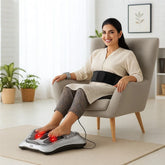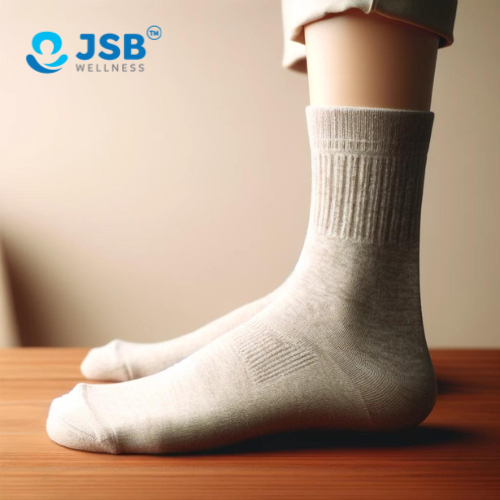What is the difference between diabetic socks and regular socks?
Introduction:
When it comes to managing diabetes, every detail counts, including the type of socks you wear. Although it might seem like a minor aspect of self-care, the difference between diabetic socks and regular socks is significant, impacting comfort, foot health, and overall well-being. This blog aims to shed light on these differences, guiding those with diabetes, or anyone interested in optimizing their foot care, towards making informed decisions about their sock choices.
Diabetic socks are designed with specific features to address the unique needs of individuals with diabetes. These needs include improving blood circulation, reducing the risk of foot injuries, and offering superior comfort. On the other hand, regular socks might not provide the same level of protection and comfort, especially for those with heightened sensitivity or particular health concerns related to diabetes.
Throughout this discussion, we will explore the various design elements that differentiate diabetic socks from their regular counterparts, including material choices, construction techniques, and additional features that prioritize foot health. Whether you're newly diagnosed, a seasoned diabetes manager, or simply curious about how specialized socks can contribute to better health outcomes, this blog will equip you with the knowledge you need to make choices that best support your feet. Join us as we delve into the world of diabetic socks, where comfort meets care in every stitch.
What type of socks are best for diabetics?
For individuals with diabetes, choosing the right type of socks is crucial for maintaining foot health and preventing complications. Diabetic socks are specifically designed to meet the needs of those with diabetes, offering features that regular socks do not. Here are the key characteristics to look for in diabetic socks, making them the best choice for diabetics:
-
Non-Elastic or Loose-Fitting Tops: Diabetic socks often feature non-elastic or loose-fitting tops to improve blood circulation. Unlike regular socks, which may constrict blood flow with tight elastic bands, diabetic socks are designed to minimize pressure on the leg and ankle.
-
Moisture-Wicking Materials: Keeping feet dry is essential for preventing infections, especially in diabetics who may have reduced sensation in their feet. Diabetic socks are made from materials that wick moisture away from the skin, such as bamboo, wool, or blends containing acrylic and special synthetic fibers.
-
Seamless Construction: To reduce the risk of rubbing and blisters, diabetic socks are typically made without seams or with very flat seams. This is crucial for those with neuropathy, as even minor injuries can lead to serious complications.
-
Padding and Cushioning: Extra padding in areas prone to pressure or injury, like the soles, heels, and toes, can provide additional comfort and protection. This cushioning can help absorb impact and reduce the risk of foot ulcers.
-
Antimicrobial Features: Some diabetic socks are treated with antimicrobial agents to prevent the growth of bacteria and fungi, reducing the risk of infections.
-
Warmth: Good diabetic socks should also help in maintaining optimal foot temperature, aiding in circulation. However, they should not be too tight or restrictive.
-
White or Light-Colored Fabric: Wearing socks that are white or light-colored can help in early detection of wounds and sores, as these colors make it easier to spot bleeding or discharge.
Choosing the right diabetic socks involves considering individual needs, such as level of foot sensitivity, presence of neuropathy or peripheral artery disease (PAD), and personal comfort preferences. It's also recommended to consult with a healthcare professional to get personalized advice based on your specific condition and needs.
So, What is the difference between diabetic socks and regular socks?
The difference between diabetic socks and regular socks lies in their design, materials, and features, all of which are tailored to address the specific health needs and comfort requirements of individuals with diabetes. Here's a detailed comparison to highlight these differences:
1. Material:
- Diabetic Socks: They are often made from finer-textured fabrics such as bamboo, wool, or moisture-wicking blends that keep the feet dry and reduce the risk of fungal infections. These materials are also typically softer and less irritating to sensitive skin.
- Regular Socks: These can be made from a variety of materials, including cotton, wool, nylon, and polyester. The focus is more on durability, style, or specific activities like sports, rather than the health and comfort of the feet.
2. Fit and Elasticity:
- Diabetic Socks: They are designed to fit snugly without constricting blood flow. This is crucial for diabetics who may suffer from circulation problems. Many diabetic socks feature non-elastic bands to prevent constriction and ensure better blood circulation.
- Regular Socks: These often have elastic bands at the top to keep the socks in place. However, this can restrict circulation, especially in those with vascular problems.
3. Seams:
- Diabetic Socks: They are typically seamless or have very flat seams to reduce the risk of rubbing and blisters, which is particularly important for individuals with neuropathy (nerve damage) who may not feel minor injuries.
- Regular Socks: These may have prominent seams that can irritate the skin or cause blisters during prolonged wear, which might not be a concern for people without sensory loss.
4. Padding and Cushioning:
- Diabetic Socks: Extra padding and cushioning are often provided at sensitive areas, such as the soles, to protect against pressure sores and injuries. This cushioning is carefully calibrated to enhance comfort without making the socks too thick to fit into shoes comfortably.
- Regular Socks: Padding varies depending on the purpose of the sock (e.g., athletic socks may have extra cushioning in the soles), but it is not specifically designed with the needs of diabetics in mind.
5. Moisture Control:
- Diabetic Socks: They are designed to be highly breathable and effective at moisture management to keep feet dry, reducing the risk of fungal infections.
- Regular Socks: While some sports-oriented socks offer moisture-wicking properties, regular socks do not consistently provide the level of moisture control needed by those with diabetes.
6. Antimicrobial Features:
- Diabetic Socks: Some are treated with antimicrobial agents to prevent the growth of bacteria and fungi, reducing the risk of infections.
- Regular Socks: Antimicrobial treatment is less common and is usually not a primary concern in the design.
In summary, diabetic socks offer specialized features to accommodate the health needs of individuals with diabetes, including improved circulation, reduced risk of injury, and enhanced comfort. Regular socks may meet general needs but do not address the specific risks and challenges faced by those with diabetes.
Do diabetic socks really work?
Yes, diabetic socks do work in terms of providing specific benefits tailored to the needs of individuals with diabetes. Their design and features are aimed at addressing common foot-related complications associated with diabetes, such as neuropathy (nerve damage), poor circulation, and an increased risk of infection. Here's how diabetic socks can be beneficial:
1. Improving Blood Circulation:
Diabetic socks are designed to promote better circulation. They typically have a non-binding design that doesn’t constrict the legs or feet, reducing the risk of circulation problems. This is especially important for individuals with diabetes who are at risk for vascular issues.
2. Reducing Risk of Foot Injuries:
The seamless or minimal seam design of diabetic socks reduces friction and pressure points, minimizing the risk of blisters, ulcers, and sores. For someone with neuropathy, this is crucial because they may not feel these injuries until they become severe.
3. Preventing Infections:
By keeping the feet dry and incorporating antimicrobial properties, diabetic socks reduce the risk of fungal and bacterial infections. This is particularly beneficial since individuals with diabetes heal more slowly and are more susceptible to infections.
4. Providing Comfort and Reducing Swelling:
The soft, moisture-wicking materials used in diabetic socks, along with features like extra cushioning, make them more comfortable to wear. Additionally, some diabetic socks are designed to minimize swelling, making them suitable for those with edema.
5. Enhancing Foot Health:
Overall, diabetic socks support better foot health. By addressing the specific risks associated with diabetes, they can help prevent some of the foot complications that can lead to more serious consequences, including the need for hospitalization or surgery.
Clinical Evidence:
Research and clinical studies support the benefits of diabetic socks in preventing complications. For example, studies have shown that the use of diabetic socks can significantly reduce the risk of foot ulcers among people with diabetes, who are at high risk for lower-extremity complications.
It's important for individuals with diabetes to consult with their healthcare provider to understand their specific needs and whether diabetic socks would be beneficial for them. While diabetic socks are beneficial, they are just one component of a comprehensive foot care plan for individuals with diabetes.
Conclusion on What is the difference between diabetic socks and regular socks?
To sum up, the primary distinction between diabetic socks and regular socks lies in their purpose and design. Diabetic socks are specifically engineered to address the unique foot care needs of individuals with diabetes, including improving circulation, reducing the risk of foot injuries, and providing superior comfort and protection. They are made with special materials, have a non-binding fit to avoid constriction, feature minimal or no seams to reduce irritation, and often include additional padding for protection against pressure points.
Regular socks, while varied in design and purpose, typically do not offer these specialized features and may not meet the specific health requirements of those with diabetes. Therefore, while diabetic socks present a targeted solution to help prevent complications associated with diabetes, regular socks are designed for the general population without specific health considerations in mind.
The key takeaway is that choosing the right type of socks can significantly impact foot health, especially for those managing diabetes. Diabetic socks offer a proactive approach to foot care, emphasizing prevention, comfort, and safety, which are critical for maintaining mobility and quality of life for individuals with diabetes.











